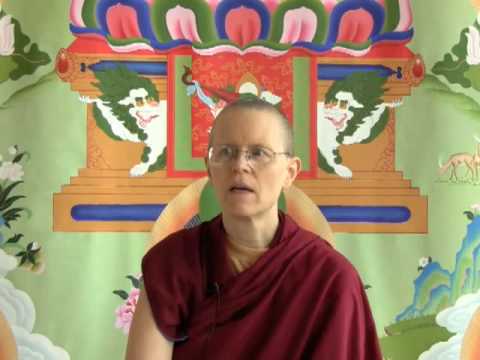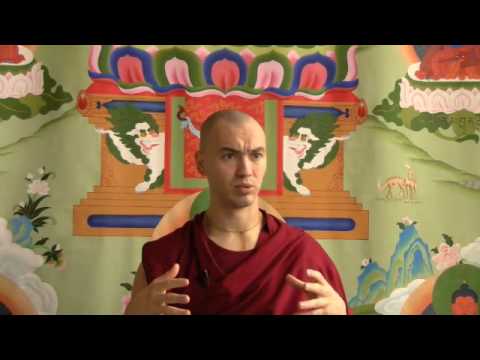Fearlessness and refuge
Fearlessness and refuge
Part of a series of Bodhisattva’s Breakfast Corner talks given during the Green Tara Winter Retreat from December 2009 to March 2010.
- Fearlessness is one of the qualities of the Buddha
- The Buddha cannot remove our fear or give us realizations
- The Buddha has provided the road map for us to follow
Green Tara Retreat 041: Fearlessness and refuge (download)
I am not going to talk about my fear and anxiety; I can go on for hours, I can go on for days. But what I did want to share is what I believe and what I feel in relationship to the Three Jewels. What they are for me, what they are becoming. And also a little bit about this fearlessness quality.
Geshe Sopa—who wrote the Steps on the Path to Enlightenment: A Commentary on Tsongkhapa’s Lamrim Chenmo, Vol. 1: The Foundation Practices, this incredible commentary on Lamrim Chenmo—states that fearlessness is in those that no longer are under the power of uncontrolled causes and conditions. That’s what he describes as fearlessness. And so, who could that can be? In my mind that is, of course, the Buddha who has that quality. In this state that he has attained fearlessness is one of his qualities. He attained that by intentionally creating the causes to remove all the obstacles that caused suffering in his own mind, and at the same time intentionally created the causes and conditions to attain all the realizations, liberation, and enlightenment. He created the causes to attain all the good qualities of love, compassion, wisdom, skillful means, and as a result he attained the mind of omniscience. I can see how that would certainly bring the state of fearlessness, when you no longer have to worry about rebirth, and suffering, and ignorance, rising of afflictions, and karma that is resulted by the afflictions. Out of his great compassion he then went about and laid out one of the most detailed remarkable road maps for the rest of us to also create causes and conditions for our own liberation and enlightenment.
Now, the thing that I had to ponder this past month is letting go of my Christian conditioning that says, “Well, if the Buddha has a mind of omniscience, that has cultivated all these good qualities, and he has all the skillful means, why can’t he do this for me? Why can’t he take that bowl and just pop me on the head, so that I can have realizations, so that I can sort of alleviate the suffering once and for all. Why can’t he do that?” So, letting go of this, “Save me, save me, help me, help me,” conditioning of my Christian religious background. Knowing that he can’t because the universal law of cause and effect is in play, and he can’t do that for me. But what he has done is that he has presented to all sentient beings this remarkable road map. And so, going from being upset over these past few weeks, I’ve got to feeling really empowered. His fearlessness instilled in him, he’s guaranteeing that if we follow this road map, complete with changes and elevations, lines, directions, caution signs in the road, that we will attain the same state of liberation and enlightenment. He guarantees this. Alex Berzin says, “This is the promise.” Out of the state of fearlessness, he guarantees this for all sentient beings. He does that through these beautiful lamrim teachings, the thought trainings, the teachings on emptiness, bodhicitta—these are the signs of the road map.
Geshe Sopa has this whole idea about creating the causes and conditions for our enlightenment and this is the part that I have found to be really quite profound. He says that, “When you seek protection from the Three Jewels,” which is how we start cultivating the safe direction, following the road map to the state of fearlessness, “you are going for refuge to a spiritual rule, the law of cause and effect.” The Three Jewels don’t make this rule. The Buddha just explains what he has seen, what he’s experienced. He explains what kinds of causes bring what type of results. This is that whole thing that I’ve heard over the past eleven years at least five dozen times: that the Buddha has taught us what to abandon and what to cultivate. “The Dharma encompasses this natural law, it teaches the process of causation. That is the true refuge.” And since the entire universe exists due to causes and conditions, why can’t the mind of an enlightened being come into play using the same natural law?
For me, I really feel that there’s something that has shifted. This gift that the Buddha has given us, this legacy, this true refuge: the Dharma, these are all about creating the causes and conditions for our own enlightenment. This road map is so detailed and so specific. Now, I have to say that my personal experience is that I’m taking a lot of exits. I’m going off to the drug store, and I’m going to the casino, I am going to the water park, and the scenic overview along the way, the cheesy motel. The road map has those exits too. In the beginning the road’s really rough and slow going, and so you get distracted, but there’s always an entrance ramp back onto the road. And the Arya Sangha are now on the superhighway part of this road. They’re not even looking at the exits, there are not even any exit signs, any gambling casinos and water parks and B&B’s. They’re straight on to the superhighway.
Using the natural law of cause and effect, there’s something in my mind, a deeper understanding of how powerful the Dharma is, and how powerful our minds are by using a natural law that controls. As it says in The Three Principle Aspects of the Path, “One who sees the infallible cause and effect of all phenomena in cyclic existence and beyond”—Nirvana, Buddhahood—“and destroys all false perceptions of their inherent existence has entered the path which pleases the Buddha.”
If we understand the infallible cause and effect of everything that exists, including our own mind, the cosmos that was created by cause and effect, enlightened mind is possible. So the next time that you hear Venerable Chodron say—she says that with such confidence, such joy in her voice—“Be content to create the causes,” this is what she’s talking about. That is so profound. That statement has shifted into a level of profundity for me in the past few weeks. She’s talking about creating the causes for our own enlightenment and the Buddha has given us the road map for that. That’s my thinking and pondering on the Three Jewels. They are reliable objects of refuge. That is where the fearlessness will arise.
Venerable Thubten Semkye
Ven. Semkye was the Abbey's first lay resident, coming to help Venerable Chodron with the gardens and land management in the spring of 2004. She became the Abbey's third nun in 2007 and received bhikshuni ordination in Taiwan in 2010. She met Venerable Chodron at the Dharma Friendship Foundation in Seattle in 1996. She took refuge in 1999. When the land was acquired for the Abbey in 2003, Ven. Semye coordinated volunteers for the initial move-in and early remodeling. A founder of Friends of Sravasti Abbey, she accepted the position of chairperson to provide the Four Requisites for the monastic community. Realizing that was a difficult task to do from 350 miles away, she moved to the Abbey in spring of 2004. Although she didn't originally see ordination in her future, after the 2006 Chenrezig retreat when she spent half of her meditation time reflecting on death and impermanence, Ven. Semkye realized that ordaining would be the wisest, most compassionate use of her life. View pictures of her ordination. Ven. Semkye draws on her extensive experience in landscaping and horticulture to manage the Abbey's forests and gardens. She oversees "Offering Volunteer Service Weekends" during which volunteers help with construction, gardening, and forest stewardship.


